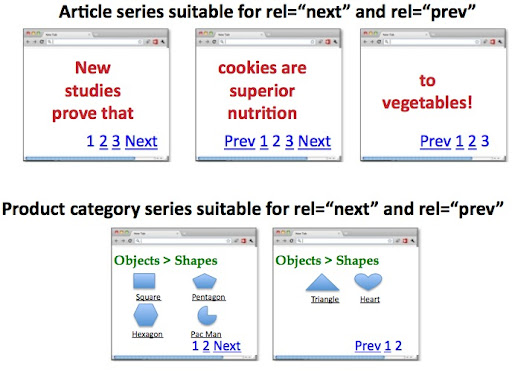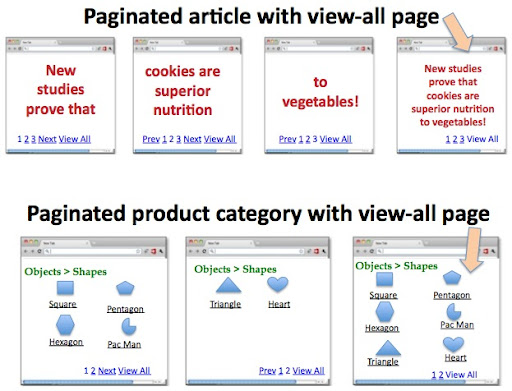Thursday, September 15, 2011
Much like rel="canonical"
acts a strong hint for duplicate content, you can now use the HTML link elements rel="next"
and rel="prev"
to indicate the relationship between component URLs in a paginated series. Throughout the web, a
paginated series of content may take many shapes—it can be an article divided into several
component pages, or a product category with items spread across several pages, or a forum thread
divided into a sequence of URLs. Now, if you choose to include rel="next"
and rel="prev"
markup on the component pages within a series, you're giving Google a
strong hint that you'd like us to:
- Consolidate indexing properties, such as links, from the component pages/URLs to the series as a
whole (that is, links should not remain dispersed between
page-1.html,page-2.html, etc., but be grouped with the sequence). - Send users to the most relevant page/URL—typically the first page of the series.

rel="next"
and rel="prev"
.There's an exception to the rel="prev"
and rel="next"
implementation:
If, alongside your series of content, you also offer users a view-all page, or if you're
considering a view-all page, please see our post on View-all in search results
for more
information. Because view-all pages are most commonly preferred by searchers, we do our best to
surface this version when appropriate in results rather than a component page (component pages are
more likely to surface with rel="next"
and rel="prev"
).
If you don't have a view-all page or you'd like to override Google returning a view-all page, you
can use rel="next"
and rel="prev"
as described in this post.

Outlining your options
Here are three options for a series:
- Leave whatever you have exactly as-is. Paginated content exists throughout the web and we'll
continue to strive to give searchers the best result, regardless of the page's
rel="next"/rel="prev"HTML markup—or lack thereof. - If you have a view-all page, or are considering a view-all page, see our post on View-all in search results .
- Hint to Google the relationship between the component URLs of your series with
rel="next"andrel="prev". This helps us more accurately index your content and serve to users the most relevant page (commonly the first page). Implementation details below.
Implementing rel="next"
and rel="prev"
If you prefer option 3 (above) for your site, let's get started! Let's say you have content paginated into the URLs:
https://www.example.com/article?story=abc&page=1 https://www.example.com/article?story=abc&page=2 https://www.example.com/article?story=abc&page=3 https://www.example.com/article?story=abc&page=4
On the first page, https://www.example.com/article?story=abc&page=1
, you'd include
in the <head>
section:
<link rel="next" href="https://www.example.com/article?story=abc&page=2" />
On the second page, https://www.example.com/article?story=abc&page=2
:
<link rel="prev" href="https://www.example.com/article?story=abc&page=1" /> <link rel="next" href="https://www.example.com/article?story=abc&page=3" />
On the third page, https://www.example.com/article?story=abc&page=3
:
<link rel="prev" href="https://www.example.com/article?story=abc&page=2" /> <link rel="next" href="https://www.example.com/article?story=abc&page=4" />
And on the last page, https://www.example.com/article?story=abc&page=4
:
<link rel="prev" href="https://www.example.com/article?story=abc&page=3" />
A few points to mention:
- The first page only contains
rel="next"and norel="prev"markup. - Pages two to the second-to-last page should be doubly-linked with both
rel="next"andrel="prev"markup. - The last page only contains markup for
rel="prev", notrel="next". -
rel="next"andrel="prev"values can be either relative or absolute URLs (as allowed by the<link />tag). And, if you include a<base/>link in your document, relative paths will resolve according to the base URL. -
rel="next"andrel="prev"only need to be declared within the<head>section, not within the document<body>. - We allow
rel="previous"as a syntactic variant ofrel="prev"links. -
rel="next"andrel="previous"on the one hand andrel="canonical"on the other constitute independent concepts. Both declarations can be included in the same page. For example,https://www.example.com/article?story=abc&page=2&sessionid=123may contain:<link rel="canonical" href="https://www.example.com/article?story=abc&page=2" /> <link rel="prev" href="https://www.example.com/article?story=abc&page=1&sessionid=123" /> <link rel="next" href="https://www.example.com/article?story=abc&page=3&sessionid=123" />
-
rel="prev"andrel="next"act as hints to Google, not absolute commands. - When implemented incorrectly, such as omitting an expected
rel="prev"orrel="next"designation in the series, we'll continue to index the page(s), and rely on our own heuristics to understand your content.
More information can be found in our Help Center , or join the conversation in our Webmaster Help Forum !


